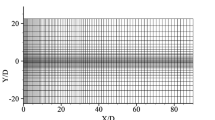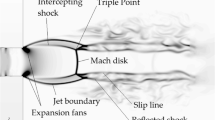Abstract
The behavior of compressible jets originated from initially turbulent pipe flows issuing in still air has been investigated at three different subsonic Mach numbers, 0.3, 0.6 and 0.9. Helium, nitrogen and krypton gases were used to generate the jet flows and investigate the additional effects of density on the flow structure. Particle image velocimetry, high-frequency response pressure transducers and thermocouples were used to obtain velocity, Mach number and total temperature measurements inside the flow field. The jets were formed at the exit of an adiabatic compressible frictional turbulent pipe flow, which was developing toward its corresponding sonic conditions inside the pipe, and continued to expand within the first four diameters distance after it exited the pipe. Theoretical considerations based on flow self-similarity were used to obtain the decay of Mach number along the centerline of the jets for the first time. It was found that this decay depends on two contributions, one from the velocity field which is inversely proportional to the distance from the exit and one from the thermal field which is proportional to this distance. As a result, a small non-linearity in the variation of the inverse Mach number with downstream distance was found. The decay of the Mach number at the centerline of the axisymmetric jets increases by increasing the initial Mach number at the exit of the flow for all jets. The decay of mean velocity at the centerline of the jets is also higher at higher exit Mach numbers. However, the velocity non-dimensionalized by the exit velocity seems to decrease faster at low exit Mach numbers, suggesting a reduced mixing with increasing exit flow Mach numbers. Helium jets were found to have the largest spreading rate among the three different gas jets used in the present investigation, while krypton jets had the lowest spreading rate. The spreading rate of each gas decreases with increasing its kinetic energy relatively to its internal energy.












Similar content being viewed by others
Abbreviations
- D :
-
jet exit diameter
- D e :
-
equivalent jet exit diameter
- M :
-
Mach number U/α
- M E :
-
energy based Mach number M E = (1/2U 2/c p T)1/2 = (1/2γ(γ−1))1/2 M
- M CL :
-
centerline Mach number
- M J :
-
jet exit Mach number
- p :
-
static pressure
- p 0 :
-
total pressure
- T :
-
static temperature
- St:
-
Stokes number \( {\text{St}} = {\frac{{{{\rho_{\text{p}} d_{\text{p}}^{2} } \mathord{\left/ {\vphantom {{\rho_{\text{p}} d_{\text{p}}^{2} } {18\mu }}} \right. \kern-\nulldelimiterspace} {18\mu }}}}{{D/U_{\text{J}} }}} \)
- T 0 :
-
total temperature
- γ = c p/c v :
-
ratio of specific heats
- λU = U a/U J :
-
velocity ratio
- λρ = ρa/ρJ :
-
density ratio
- λγ = γa/γJ :
-
ratio of specific heats ratio
- ρa :
-
ambient air density
- ρJ :
-
jet exit flow density
References
Agui JH, Briassulis G, Andreopoulos Y (2005) Studies of interactions of a propagating shock wave with decaying grid turbulence: velocity and vorticity field. J Fluid Mech 524:143–195
Andreopoulos Y, Agui JH, Briassulis G (2000a) Turbulence–shock wave interaction. Ann Rev Fluid Mech 32:309–345
Andreopoulos Y, Agui JH, Wang Z, Hermening K (2000b) Interactions of turbulent jets with traveling shock waves. AIAA paper 2000-0929
Andreopoulos Y, Gong M, Wang Z, Xanthos S (2003) A probe to measure direction and strength of moving shocks or blast waves. AIAA J 41(3):476–484
Becher HA, Hottel HC, Williams GC (1967) The nozzle-fluid concentration field of the round, turbulent, free jet. J Fluid Mech 30(Pt. 2):285–303
Birch SL, Eggers JM (1972) A critical review of the experimental data on turbulent shear layers. NASA SP 321
Bogdanoff DW (1983) Compressibility effects in turbulent shear layers. AIAA J 21:926–927
Bradshaw P (1977) Compressible turbulent shear layers. Ann Rev Fluid Mech 9:33–54
Brown GL, Roshko A (1974) On density effects and large structure in turbulent mixing layers. J Fluid Mech 64:775–816
Chinzei N, Masuya G, Komuro T, Murakami A, Kudou K (1986) Spreading of two-stream supersonic turbulent mixing layers. Phys Fluid 29:1345–1347
Clemens NT, Mungal MG (1992) Two- and three-dimensional effects in the supersonic mixing layer. AIAA J 30:973–981
Clemens NT, Mungal MG (1995) Large-scale structure and entrainment in the supersonic turbulent mixing layer. J Fluid Mech 284:171–216
Colonius T, Lele SK, Moin P (1997) Sound generation in a mixing layer. J Fluid Mech 330:375–409
Crow SC, Champagne FH (1971) Orderly structure in jet turbulence. J Fluid Mech 48:547–591
Dahm WA, Dimotakis PE (1987) Measurements of entrainment and mixing in turbulent jets. AIAA J 25(9):1216–1223
Elliott GS, Samimy M (1990) Compressibility effects in free shear layers. Phys Fluid A 2(7):1231–1240
Ferdman E, Ötügen MV, Kim S (2000) Effect of initial velocity profile on the development of round jets. J Propuls Power 16(4):676–686
Fourguette DC, Mungal MG, Dibble RW (1991) Time evolution of the shear layer of a supersonic axisymmetric jet. AIAA J 29(7):1123–1130
Freund JB (2001) Noise sources in a low-reynolds-number turbulent jet at Mach 0.9. J Fluid Mech 438:277–305
Freund JB, Lele SK, Moin P (2000) Compressibility effects in a turbulent annular mixing layer part 1. Turbulence and growth rate. J Fluid Mech 421:229–267
Goebel SG, Dutton JC (1991) Velocity measurements of compressible, turbulent mixing layers. AIAA J 29(4):538–546
Gutmark EJ, Schadow KC, Yu KH (1995) Mixing enhancement in supersonic free shear flows. Ann Rev Fluid Mech 27:375
Hall JL, Dimotakis PE, Rosemann H (1993) Experiments in nonreacting compressible shear layers. AIAA J 31:2247–2254
Hussain AKMF, Clark AR (1977) Upstream influence on the near field of a plane turbulent jet. Phys Fluid 20:1416–1922
Islam MT, Ali MAT (1997) Mean velocity and static pressure distributions of a circular jet. AIAA J 35(1):196–198
Jacquin L, Geffroy P (1997) Amplification and reduction of turbulence in a heated jet/shock interaction. VIII turbulent shear flows (eds: Durst et al.), pp 229–248, Springer Verlag
Lau JC (1981) Effects of exit Mach number and temperature on mean flow and turbulence characteristics in round jets. J Fluid Mech 105:193–218
Lau JC, Morris PJ, Fisher MJ (1979) Measurements in subsonic and supersonic free jets using a laser velocimeter. J Fluid Mech 93:1–27
Lele SK (1994) Compressibility effects on turbulence. Ann Rev Fluid Mech 26:211–254
Longmire EK, Eaton J (1992) Structure of a particle laden round jet. J Fluid Mech 236:217–243
Luo K, Klein M, Fan RJ, Cen KF (2006) Effects on particle dispersion by turbulent transition in a jet. Phys Lett A 357:345–350
Maxey MR (1987) The gravitational settling of aerosol particles in homogeneous turbulence and random flow fields. J Fluid Mech 174:441–453
Maydew RC, Reed JF (1963) Turbulent mixing of compressible free jets. AIAA J 1:1443–1444
McLaughlin DK, Morrison GL, Troutt TR (1975) Experiments on the instability waves in supersonic jets and their acoustic radiation. J Fluid Mech 69:73–95
Morrison GL, McLaughlin DK (1979) Noise generated by instabilities in low Reynolds number supersonic jets. J Sound Vib 65:177–191
Narayanan S, Barber TJ, Polak DR (2002) High subsonic jet experiments. Turbulence and noise generation studies. AIAA J 40(3):430–437
Panchapakesan NR, Lumley JL (1993) Turbulence measurements in axisymmetric jets of air and helium part 1. J Fluid Mech 246:197–223
Panda J, Seasholtz RG (2002) Experimental investigation of density fluctuations in high-speed jets and correlation with generated noise. J Fluid Mech 450:97–130
Pantano C, Sarkar S (2002) A study of compressibility effects in the high-speed turbulent shear layer using direct simulation. J Fluid Mech 451:329–371
Papadopoulos G, Pitts WM (1998) Scaling the near-field centerline mixing behavior of axisymmetric turbulent jets. AIAA J 36(9):1635–1642
Papamoschou D, Roshko A (1988) The compressible turbulent shear layer: an experimental study. J Fluid Mech 197:453–477
Pope SB (2000) Turbulent flows. Cambridge University Press
Ribault C (2005) Large eddy simulation of compressible mixing layers. Int J Dyn Fluid, 1(1), 87–111. ISSN 0973-1784
Richards CD, Pitts WM (1993) Global density effects on the self-preservation behavior of turbulent free jets. J Fluid Mech 254:417–435
Sarkar S (1995) The stabilizing effect of compressibility in turbulent shear flow. J Fluid Mech 282:163–186
Smits AJ, Dussauge JP (1996) Turbulent shear layers in supersonic flow. AIP Press, New York
Spina EF, Smits AJ, Robinson SK (1994) The physics of supersonic turbulent boundary layers. Ann Rev Fluid Mech 26:287
Thring MW, Newby MP (1952) Combustion length of enclosed turbulent jet flames. Proceedings of the 4th symposium (international) on combustion, The Williams and Wilkins Co., Baltimore, MD, pp 789–796
Vreman AW, Sandham ND, Luo KH (1996) Compressible mixing layer growth rate and turbulence characteristics. J Fluid Mech 320:235–258
Wang Z (2003) Experimental investigation of compressible turbulent jets. PhD Thesis, City University of New York
Wygnanski I, Fiedler H (1969) Some measurements in the self-preserving jet. J Fluid Mech 38:577–612
Zaman KBMQ (1986) Flow field and near and far sound field of a subsonic jet. Sound Vib 106:1–11
Zaman KBMQ (1998) Asymptotic spreading rate of initially compressible jets-experiment and analysis. Phys Fluid 10(10):2652–2660
Acknowledgments
The authors would like to thank Drs. Savvas Xanthos and Minwei Gong for helping with the experimental set-up. The financial support provided by NASA Glenn Research Center through Grant #: NAG3-2163 is greatly appreciated.
Author information
Authors and Affiliations
Corresponding author
Rights and permissions
About this article
Cite this article
Wang, Z., Andreopoulos, Y. Density and compressibility effects in turbulent subsonic jets part 1: mean velocity field. Exp Fluids 48, 327–343 (2010). https://doi.org/10.1007/s00348-009-0738-y
Received:
Revised:
Accepted:
Published:
Issue Date:
DOI: https://doi.org/10.1007/s00348-009-0738-y




